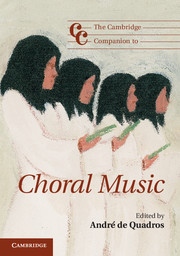Book contents
- Frontmatter
- 1 Introduction: choral music – a dynamic global genre
- Part I Choral music: history and context
- Part II Choral music the world over
- 6 Choral music and tradition in Europe and Israel
- 7 Canada's choral landscape
- 8 A multiplicity of voices: choral music in the United States
- 9 A hundred years of choral music in Latin America 1908–2008
- 10 Choral music in East Asia: China, Japan, and Korea
- 11 New voices in ancient lands: choral music in South and Southeast Asia
- 12 From chanting the Quran to singing oratorio: choral music in West and Central Asia
- 13 Voices of the Pacific: the (ch)oral traditions of Oceania
- 14 Choral music in Africa: history, content, and performance practice
- Part III Choral philosophy, practice, and pedagogy
- Notes
- Select bibliography
- Index
- Cambridge Companions to Music
6 - Choral music and tradition in Europe and Israel
from Part II - Choral music the world over
Published online by Cambridge University Press: 28 September 2012
- Frontmatter
- 1 Introduction: choral music – a dynamic global genre
- Part I Choral music: history and context
- Part II Choral music the world over
- 6 Choral music and tradition in Europe and Israel
- 7 Canada's choral landscape
- 8 A multiplicity of voices: choral music in the United States
- 9 A hundred years of choral music in Latin America 1908–2008
- 10 Choral music in East Asia: China, Japan, and Korea
- 11 New voices in ancient lands: choral music in South and Southeast Asia
- 12 From chanting the Quran to singing oratorio: choral music in West and Central Asia
- 13 Voices of the Pacific: the (ch)oral traditions of Oceania
- 14 Choral music in Africa: history, content, and performance practice
- Part III Choral philosophy, practice, and pedagogy
- Notes
- Select bibliography
- Index
- Cambridge Companions to Music
Summary
A quick personal scan of the choral world in Europe at large, between Moscow (Russia) and Reykjavik (Iceland), indicates that more than 30 million Europeans, approximately 4 percent of the population, participate in choral music at the beginning of the twenty-first century. Europe's long-standing choral tradition has consisted since as early as the 1830s until well after World War II of both a musical and a socio-political component. These components are largely interconnected, as for example when a composer writes choral music in which the social and political circumstances of its performance – for example, singing together for a political event or singing in a choir which is formed by a specific professional group such as firemen or diamond cutters – are incorporated. Since the 1960s this socio-political tradition has diminished.
Well into the twentieth century, most choirs, except for opera choruses and later radio choirs too, were composed of amateurs. Before World War II, some professional chamber choirs were founded primarily to perform a cappella music. After the war, however, some of the best amateur choirs (for example, the Berlin-based Ernst Senff Chor, which is now semi-professional, the Arnold Schoenberg Chor in Vienna, and the London Philharmonic and the London Symphony choirs) began to perform on a level that is difficult for even professional choirs to attain. The main difference between amateurs and professionals is that professional symphonic and professional chamber choirs offer full seasons and perform a broad repertoire, and are thus comparable to professional symphony orchestras. Another difference is that professional choirs employ only fully trained professional singers.
- Type
- Chapter
- Information
- The Cambridge Companion to Choral Music , pp. 77 - 103Publisher: Cambridge University PressPrint publication year: 2012
- 1
- Cited by



